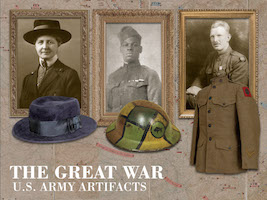Special Publications

THE GREAT WAR: U.S. ARMY ARTIFACTS
Sarah G. Forgey, General Editor
Special Publications
CMH Pub 70-128, Cloth
2018; 190 pages, tables, illustrations
GPO S/N: Pending
This book uses high-resolution photographs and a wealth of historical research to showcase objects relating to the First World War from the collections of the Army Museum Enterprise (AME) to mark the centennial of World War I. The artifacts presented in the book are a small sample of the more than 34,000 World War I artifacts in the AME's vast collection. Although the soldiers and civilians who served during the Great War are no longer here, we can hear and understand their stories through these objects. The artifacts give us a profound connection to the events of one hundred years ago. Technological innovation made World War I the first modern, mechanized, and industrial war, and the artifacts show how those who participated in the war made sense of their difficult surroundings on a day-to-day basis. Air combat became common for the first time. A corporal's diary includes drawings and notes on aircraft tail shapes to assist him in identifying whether a plane was friend or foe. In the trenches, the doughboys routinely faced poison gas attacks and had to carry respirators and protective masks. They sometimes personalized these objects with their name or their unit's insignia. World War I also brought about advancements in medicine and medical treatments. Motorized ambulances could transport the sick and wounded away from the infectious conditions of the battlefield, increasing their possibility of survival. Red Cross brassards and red vests identified medical orderlies and ambulance drivers. The United States faced many logistical challenges in fighting a war overseas. Soldiers not only battled the enemy on the front lines, but also established base camps, built roads, constructed rail lines and bridges, kept draft animals and carrier pigeons, and prepared food. Mobile kitchens were developed to serve hot food to the troops at the front. During the Great War, the U.S. Army grew in unprecedented numbers. Soldiers came from every state in the nation and included African, Hispanic, and Native Americans. Some soldiers brought a little bit of their home with them to Europe, such as a Texas flag, and some brought pieces of the war home with them, such as a vase made from a shell casing. Women also joined the war effort by attending service schools, volunteering with civilian service organizations, becoming nurses and signal operators, building equipment and armaments on the home front, and selling war bonds. Their uniforms echoed those of the soldiers they supported. These objects, and many more featured in this book, provide us with indelible insight into these lives from a hundred years ago.
* View this publication online.